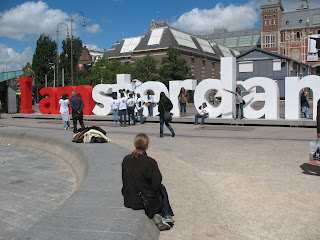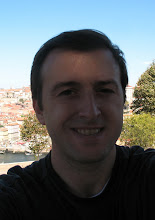Following our freshening up Kate and I left the confines of the Plantage hotel and began a trek on foot to Museumplein, a square where several museums are located, including the Van Gogh museum. Below are some snapshots taken along the way.
A spacious motor vehicle in navigating the streets of Amsterdam.


 Our cafe was near this other touristy activity the "I Amsterdam" or I am Amsterdam if you will promo- that is located in Museumplein. Huge tourist photo op... see Kate below taking it all in. I think its a better shot than all of the peeps taking the quintessential glam shots in front of this marketing campaign. And yet here we are photographing it as well...
Our cafe was near this other touristy activity the "I Amsterdam" or I am Amsterdam if you will promo- that is located in Museumplein. Huge tourist photo op... see Kate below taking it all in. I think its a better shot than all of the peeps taking the quintessential glam shots in front of this marketing campaign. And yet here we are photographing it as well... Bellies full we went into the Van Gogh museum. I really enjoyed the museum, having been a fan since I was a silly college kid with the copy of "Starry Night" on my wall. I had read Lust for Life
Bellies full we went into the Van Gogh museum. I really enjoyed the museum, having been a fan since I was a silly college kid with the copy of "Starry Night" on my wall. I had read Lust for Life back when I was in high school (a biography of Van Gogh), and enjoyed the movie as well. Vincent was a fellow epileptic (or so they claim), but I like to think I may be more mentally stable than he appeared to be. I've never once thought about cutting my ear off.... oh no, wait, I just did think about it, just now. Thankfully I don't have the right sized box to put it in, and I'm not sure who I would send it to.
Regardless of his mental state, his work was brilliant. It was interesting to learn that he was essentially a humanist of his day. He wanted to paint art for the common man. Quotes attributed to him were spread throughout the exhibits, as well as tying in the stages of his life that Van Gogh was in as he painted certain works. Also included was the work of influences, contemporaries, and other artists that he worked along side. This included Paul Gauguin (for whom Van Gogh painted the "Sunflowers" for), Georges Seurat (Pointillism), Monet & Manet. There was also a small Picasso exhibit which was great to see as our trip would be concluding in Picasso's birthplace of Barcelona.
Next entry: Vondlepark.








No comments:
Post a Comment